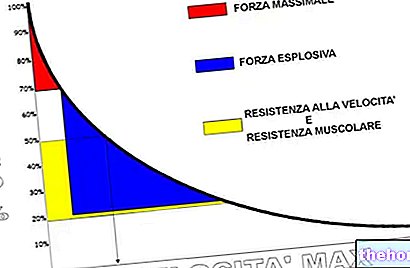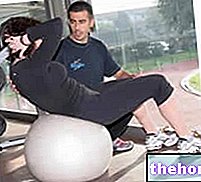Edited by Dr. Filippo Casini
How many times have you wondered why your progress has stalled?
Yet you are attentive to nutrition, integrate properly and rest properly. Furthermore, never skip a session in the gym and work hard: how is it possible - you ask yourself - that I no longer progress?

Most of the time behind the discourse that nutrition and rest are 60-70% we forget a very important factor, which if well thought out has always given great results even in times when the importance of rest and integration - as well as the foundations of "training - were not yet known as now:
but what then is this decisive factor?
TRAINING OBVIOUSLY
How many years have you been training in pyramids 12-10-8-6 and 3x8-10 series and at most you vary a few exercises every month and nothing else? Be honest? Maybe too long, so much that you don't even remember it ...
What to do, then, to shake up the training?
Assuming that you are a natural athlete, so you fear overtraining and cortisol more than who is "helped", you still need to give a boost of intensity to your training.
How can you do? Here is a solution: every 6 weeks start the training of each district with a multi-joint exercise to which to apply an intensity technique among those that I will describe and finish the training with two supersets that include an isolation exercise combined with a compound or a superslow pumping exercise. Also limit the total sets to 12 for large muscles and 9 for small muscles, resting a minimum of 45 seconds and a maximum of 90.
Before explaining in detail the various training techniques, here is a practical example of what I have just described.
Intense chest workout:
Bench press at 30 degrees: 4 sets of 8 reps, last set with stripping, rest 90 sec.
Example: I do 4 series with 100 kg, at the last repetition of the last series I reach failure, that is, I would not be able to do an eleventh one. At this point I support the barbell and as quickly as possible I take off 15 kg per side, continuing with 70 kg until yielding: 6-7 repetitions will come out, at this point I climb another 30 kg and continue with 40 kg total for another 6-7 repetitions .
I applied the stripping technique and I greatly increased the intensity; however, having applied it only to the last series, I don't risk ending up in overtraining.
I continue with 3 traditional series of pushes on the flat with dumbbells of 8-10 repetitions and I continue with 3 series of parallels 3x max, with rests of 60 seconds.
To finish the workout I apply again an intensity technique, in this case suitable to "completely exhaust" the muscle group; I perform two supersets of eight repetitions, plus eight repetitions of an isolation exercise with a compound one. Example: I perform eight repetitions of slow crosses well done, followed by 8-10 pushups, rest 40 seconds and repeat.
I finished the chest workout: I definitely triggered new growth and canceled the monotony.
So here's how a 6-week minicycle focused on stripping and rest pause could unfold:
week 1-3-5 stripping week 2-4-6 rest breaks.
Train 3 or 4 times and set the workout as follows:
As the first exercise we choose a multi-joint (for example the flat bench for the chest, the squat for the thighs, the lat-machine pull-ups or the rowing with the barbell for the back, the narrow bench press for the triceps and the curl with the barbell for the the biceps; even if the latter is not a true multi-joint, it is still a heavy exercise with free weights). We perform 4 sets of 10 repetitions with 90-second breaks. In the last set we perform stripping (weeks 1-3-5 ) or the rest breaks (weeks 2-4-6).
As a second exercise we choose another compound movement, as heavy as possible and perform a 3x8-10 repetitions without additional techniques (e.g. bench with dumbbells for the pectorals, press for the legs, row with dumbbell for the back).
As a third exercise we choose a free body exercise and if it is too light (for example lunges for the legs) we add an overload given by a weight or dumbbells and we perform 3 series of 8-10 repetitions, resting 90 seconds (for example lunges for quadriceps, chest parallels, dips between triceps benches, reverse grip pull-ups using the biceps, push-ups with very high feet on bench or back for deltoids and high chest etc.).
As a last exercise, two supersets including an isolation exercise with an 8 + 8 compound one, for example leg extensions / hack squats or cable crosses / pushups, or an isolation exercise in superslow: example leg extension 2 x 10 superslow.
Here is a "sample" of a chest workout:
1) 4x10 bench - 90 second break; in the last series, decrease the weight by 30% and continue to collapse, then drop again by 30% and continue to collapse (stripping);
2) 30 degree dumbbell bench press - 90 second break;
3) parallel with ballast or pushups with weight on the back 3x8-10 - 90 second pause;
4) superset to be repeated twice with 45-60 seconds of pause: 8 repetitions crosses with dumbbells + 8 repetitions pushed with dumbbells on the flat, or pushups on the arms if we first did parallel or parallel if we did the pushups as a third exercise.
HERE ARE SOME INTENSITY TECHNIQUES "IN DETAIL:
REST PAUSE: once you have reached the positive yield (no longer being able to complete a complete repetition without the help of a third party) you put the weight down, take 10 deep breaths and grind as many repetitions as possible, then you put the weight down again, breathe, this time 15 times, and continue until exhaustion.
STRIPPING: once you reach the positive yield (no longer being able to complete a complete repetition without the help of a third party) the weight is supported and in the shortest time the load is reduced (or reduced by a spotter) by 30%, repetitions are grinded until a new positive failure and the procedure is repeated, once again the exercise ends.
COMPOUND INSULATION SUPERSET: you choose an isolation movement, for example the crosses on the bench with dumbbells, and you perform 8 repetitions, then without stopping you continue with a compound exercise, such as the push-ups on the arms or the chest press for another 8 repetitions to failure: here is a superset.
SUPERSLOW: the negative portion of the movement is performed in about 6-7 seconds and the positive in three or 4. A maximum of 8-10 repetitions are performed: it is necessary to use a much lower load than one's habits in the specific exercise
There are also other techniques, such as forced reps, negatives, high and low reps series and giant sets for example, however to start varying a bit and without risking overtraining you can follow the example table I provided. and vary the techniques explained every 6 weeks as per example.
Good training to all and above all: GOOD GROWTH.




























